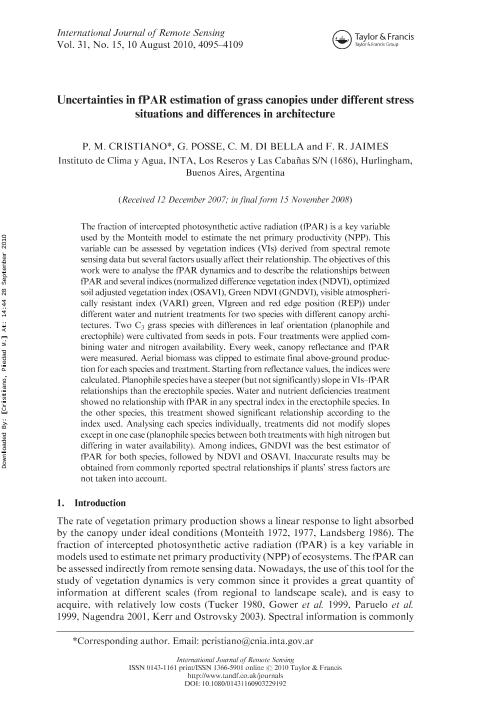Artículo
Uncertainties in fPAR estimation of grass canopies under different stress situations and differences in architecture
Fecha de publicación:
08/2010
Editorial:
Taylor & Francis Ltd
Revista:
International Journal of Remote Sensing
ISSN:
0143-1161
e-ISSN:
1366-5901
Idioma:
Inglés
Tipo de recurso:
Artículo publicado
Clasificación temática:
Resumen
The fraction of intercepted photosynthetic active radiation (fPAR) is a key variable used by the Monteith model to estimate the net primary productivity (NPP). This variable can be assessed by vegetation indices (VIs) derived from spectral remote sensing data but several factors usually affect their relationship. The objectives of this work were to analyse the fPAR dynamics and to describe the relationships between fPAR and several indices (normalized difference vegetation index (NDVI), optimized soil adjusted vegetation index (OSAVI), GreenNDVI (GNDVI), visible atmospherically resistant index (VARI) green, VIgreen and red edge position (REP)) under different water and nutrient treatments for two species with different canopy architectures. Two C3 grass species with differences in leaf orientation (planophile and erectophile) were cultivated from seeds in pots. Four treatments were applied combining water and nitrogen availability. Every week, canopy reflectance and fPAR were measured. Aerial biomass was clipped to estimate final above-ground production for each species and treatment. Starting from reflectance values, the indices were calculated. Planophile species have a steeper (but not significantly) slope inVIs-fPAR relationships than the erectophile species. Water and nutrient deficiencies treatment showed no relationship with fPAR in any spectral index in the erectophile species. In the other species, this treatment showed significant relationship according to the index used. Analysing each species individually, treatments did not modify slopes except in one case (planophile species between both treatments with high nitrogen but differing in water availability). Among indices, GNDVI was the best estimator of fPAR for both species, followed by NDVI and OSAVI. Inaccurate results may be obtained from commonly reported spectral relationships if plants' stress factors are not taken into account.
Palabras clave:
CANOPY REFLECTANCE
,
GRASSLAND
,
VEGETATION INDEX
Archivos asociados
Licencia
Identificadores
Colecciones
Articulos(SEDE CENTRAL)
Articulos de SEDE CENTRAL
Articulos de SEDE CENTRAL
Citación
Cristiano, Piedad María; Posse, G.; Di Bella, Carlos Marcelo; Jaimes, Florencia Romina; Uncertainties in fPAR estimation of grass canopies under different stress situations and differences in architecture; Taylor & Francis Ltd; International Journal of Remote Sensing; 31; 15; 8-2010; 4095-4109
Compartir
Altmétricas




